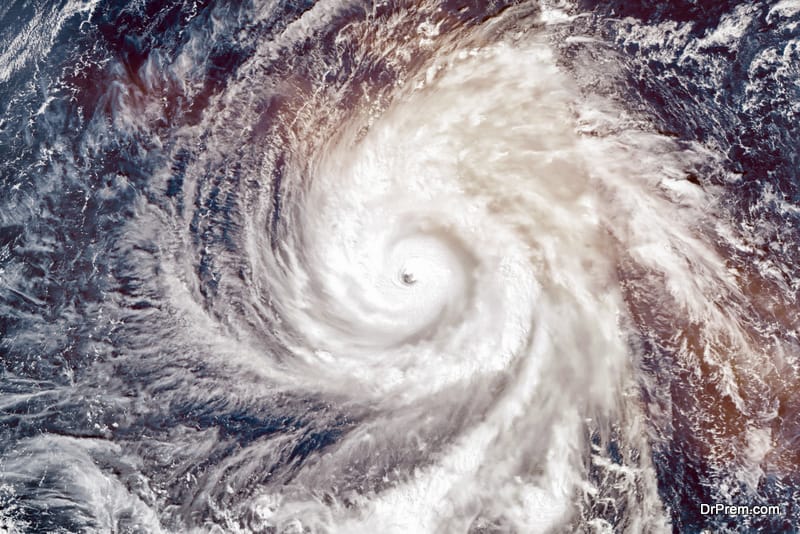Hurricane Katrina was the costliest and one of the deadliest hurricanes to hit the United States. It is believed to have caused the death of 1,500 people and damage of $80 billion.
Storm activity and rising sea surface temperatures, are known to feed hurricanes. No wonder then, that a new study indicates a link between global warming and the frequency of hurricanes especially since the number of hurricanes that strike each year has more than doubled over the past century.
The new study, published online in Philosophical Transactions of the Royal Society of London
As per the study it is said the increased numbers of tropical storms and hurricanes in the last 100 years is closely related to a 1.3-degree Fahrenheit rise in sea surface temperatures. The researchers found that average hurricane numbers jumped sharply during the 20th century, from 3.5 per year in the first 30 years to 8.4 in the earliest years of the 21st century.
Over that time, Atlantic Ocean surface temperatures increased .65 degrees, which experts call a significant increase. Changes in sea surface temperatures occurred before the periods of increased cyclones, with a rise of 0.7 degrees Fahrenheit before the 1930 period and a similar increase before the 1995 period
Greg Holland, director of the research center in Boulder, Colorado, and co-author of the study, said:
These numbers are a strong indication that climate change is a major factor in the increasing number of Atlantic hurricanes.
What is are hurricanes ?
Hurricanes are so-called tropical cyclones, characterized by a circular wind pattern fed by warm ocean waters. Tropical storms become hurricanes when their winds reach 74 miles per hour and are categorized as major hurricanes at 111 mph. Holland said the increased hurricanes since 1995 may be a transition to a period in which the number of killer storms could be higher than at any time in the past.
Skeptics say hurricane data from the early decades of the 20th century are not reliable because cyclones likely formed and died in mid-ocean, where no one knew they existed. Data that are more reliable became available in 1944 when researchers had airplane observations, and from 1970 when satellites came into use.
Growing concerns about climate change and hurricanes
Growing concern about climate change has prompted at least five attempts in Congress to set limits on U.S. emissions of carbon dioxide and other gases that can heat the atmosphere but with out many fruitful results. The record 2005 hurricane season and the flooding of New Orleans after Hurricane Katrina helped change U.S. public opinion about global warming. Now this study further concludes that weather gods are angry because of man made global warming. Is it not high time then to accept, react and curb?
Source: Reuters
Examples of how hurricanes are helping various coastal areas
Gulf of Mexico’s ‘dead zone’ from expanding
The marine ecosystem-rich Gulf of Mexico is being alarmingly bereft of its oxygen level, enough to suffocate its marine life to death. Called the ‘dead zone’ in the Gulf, the low oxygen level water-swath is expanding its stretch to reach more than 8,500 square miles by the end of this year, if it continues to recur the way it is doing each year off the Texas and Louisiana coasts. Ah! This is about the size of New Jersey! This expansion is nearly double the annual average since 1990 of 4,800 square miles.
But, the questions arise on how is it happening?
Fed by melted snow and spring flooding that occur along the Mississippi and Atchafalaya rivers, farm chemicals along with other runoff flow into the dead zone of the Gulf. This in turn, sucks up most of the region’s oxygen indirectly.
The nitrogen and phosphorus-rich runoff triggers the growth of algae. Settling and decaying in the Gulf’s bottom waters, these algae along with the bacteria that decompose them gobble the oxygen faster than what that is replenished from the surface. This means lower levels of dissolved oxygen in the water giving birth to a ‘hypoxic area.’ This can hugely affect the Gulf of Mexico’s valuable fishery.
The saving grace in this case
It is only the tropical storms that can help reduce or disrupt this increasing dead zone. The much-predicted active hurricane season, seems to be the only hope for the scientists this year. Though devastating for life on land, it is a welcome phenomenon for the valuable marine species as can help destroy the suffocating marine ‘dead zone’.
Cooler waters, trade winds protect Hawaii from killer-hurricanes
With the prediction of the Hurricane Season, the coastal region-residents are holding their breath to see what’s in store for the rest of the year. So are the people living at Hawaiian coasts — the already hurricanes-hit region in general.
But, ones living along the hurricane-prone Hawaii’s coastline seem to be more fortunate – thanks to regions’ prevailing cool waters and strong winds. The devastating Hurricane Flossie eventually mellowed down to be a tropical storm lust brushing past Hawaii’s coastline.
How have the trade winds and coole waters helped?
Relieving the fears of flooding and wind damage, the storm brought little more than what is called ‘roiling waves’. This came along with steady rain, with it approaching the islands in 15 years.
The eye of the storm moved about 95 miles south of South Point on Hawaii’s Big Island, because of a ‘small target’ in the middle of a large ocean.
A low atmospheric pressure-region to the west is weak to nonexistent trade winds prevailing over the islands. Such a situation allows the hurricanes to curve northwards. And, a strong summer jet stream protecting the islands from north-veering storms are capable of ripping the tops off the hurricanes, disperse them in turn.
But, again this does not provide people living in similar conditions to think they are safe and spared from the year’s hurricane season.


